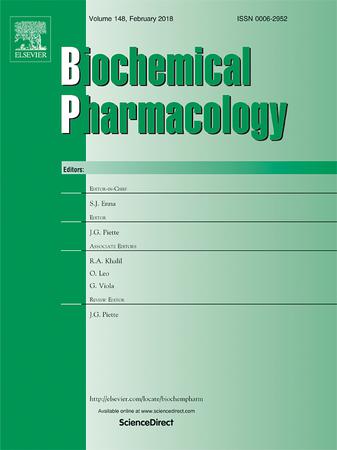Effect of PAI-1 inhibitor on pancreatic islet function and hepatic insulin resistance in db/db mice
IF 5.6
2区 医学
Q1 PHARMACOLOGY & PHARMACY
引用次数: 0
Abstract
Type 2 diabetes mellitus (T2DM) is a global health challenge, necessitating innovative antidiabetic treatments. Levels of plasminogen activator inhibitor-1 (PAI-1) are elevated in patients with T2DM and may be an important but underappreciated risk factor for diabetes. However, its relationship with T2DM remains unclear. To this end, we developed a potent and highly specific PAI-1 inhibitor named PAItrap3. We aimed to elucidate the metabolic effects of PAItrap3 using a preclinical db/db mouse model. PAItrap3 was administered to mice intravenously, followed by an assessment of biochemical markers, histopathological examination of the liver and pancreas, and evaluation of the expression of hepatic proteins integral to insulin signaling. PAItrap3 demonstrated potent efficacy in alleviating hyperglycemia and enhancing glycemic control. This therapeutic action was supported by its ability to enhance β-cell function, consequently mitigating β-cell apoptosis and preserving their integrity. Furthermore, PAItrap3 alleviated hepatic insulin resistance through the regulation of lipid and glucose metabolism, thereby maintaining the delicate homeostasis of systemic lipid and glucose metabolism. These findings suggest that PAItrap3 is a promising therapeutic candidate for T2DM. The multifaceted benefits of PAItrap3 highlight its potential to vastly improve the effectiveness and specificity of T2DM treatment paradigms.

PAI-1抑制剂对db/db小鼠胰岛功能和肝脏胰岛素抵抗的影响。
2型糖尿病(T2DM)是一个全球性的健康挑战,需要创新的抗糖尿病治疗方法。纤溶酶原激活物抑制剂-1 (PAI-1)水平在T2DM患者中升高,可能是糖尿病的一个重要但未被重视的危险因素。然而,其与2型糖尿病的关系尚不清楚。为此,我们开发了一种有效的、高度特异性的PAI-1抑制剂,命名为PAItrap3。我们旨在通过临床前db/db小鼠模型阐明PAItrap3的代谢作用。小鼠静脉注射PAItrap3,随后评估生化标志物,肝脏和胰腺的组织病理学检查,并评估胰岛素信号传导不可或缺的肝脏蛋白的表达。PAItrap3在缓解高血糖和加强血糖控制方面表现出强有力的疗效。这种治疗作用是由其增强β细胞功能的能力支持的,从而减轻β细胞凋亡并保持其完整性。此外,PAItrap3通过调节脂糖代谢来缓解肝脏胰岛素抵抗,从而维持全身脂糖代谢的微妙稳态。这些发现表明,PAItrap3是一种有希望的T2DM治疗候选药物。PAItrap3的多方面益处突出了它在极大地提高T2DM治疗范例的有效性和特异性方面的潜力。
本文章由计算机程序翻译,如有差异,请以英文原文为准。
求助全文
约1分钟内获得全文
求助全文
来源期刊

Biochemical pharmacology
医学-药学
CiteScore
10.30
自引率
1.70%
发文量
420
审稿时长
17 days
期刊介绍:
Biochemical Pharmacology publishes original research findings, Commentaries and review articles related to the elucidation of cellular and tissue function(s) at the biochemical and molecular levels, the modification of cellular phenotype(s) by genetic, transcriptional/translational or drug/compound-induced modifications, as well as the pharmacodynamics and pharmacokinetics of xenobiotics and drugs, the latter including both small molecules and biologics.
The journal''s target audience includes scientists engaged in the identification and study of the mechanisms of action of xenobiotics, biologics and drugs and in the drug discovery and development process.
All areas of cellular biology and cellular, tissue/organ and whole animal pharmacology fall within the scope of the journal. Drug classes covered include anti-infectives, anti-inflammatory agents, chemotherapeutics, cardiovascular, endocrinological, immunological, metabolic, neurological and psychiatric drugs, as well as research on drug metabolism and kinetics. While medicinal chemistry is a topic of complimentary interest, manuscripts in this area must contain sufficient biological data to characterize pharmacologically the compounds reported. Submissions describing work focused predominately on chemical synthesis and molecular modeling will not be considered for review.
While particular emphasis is placed on reporting the results of molecular and biochemical studies, research involving the use of tissue and animal models of human pathophysiology and toxicology is of interest to the extent that it helps define drug mechanisms of action, safety and efficacy.
 求助内容:
求助内容: 应助结果提醒方式:
应助结果提醒方式:


